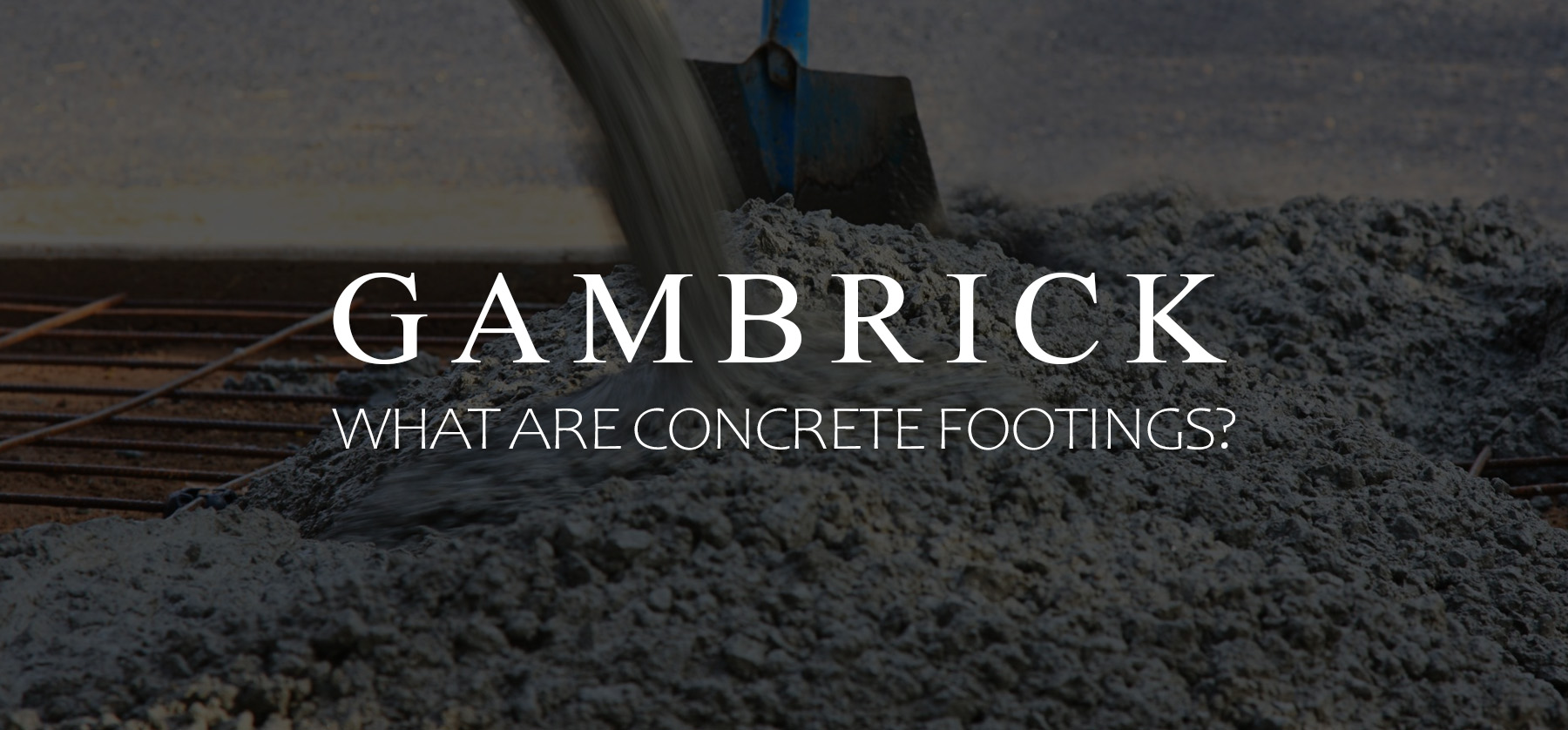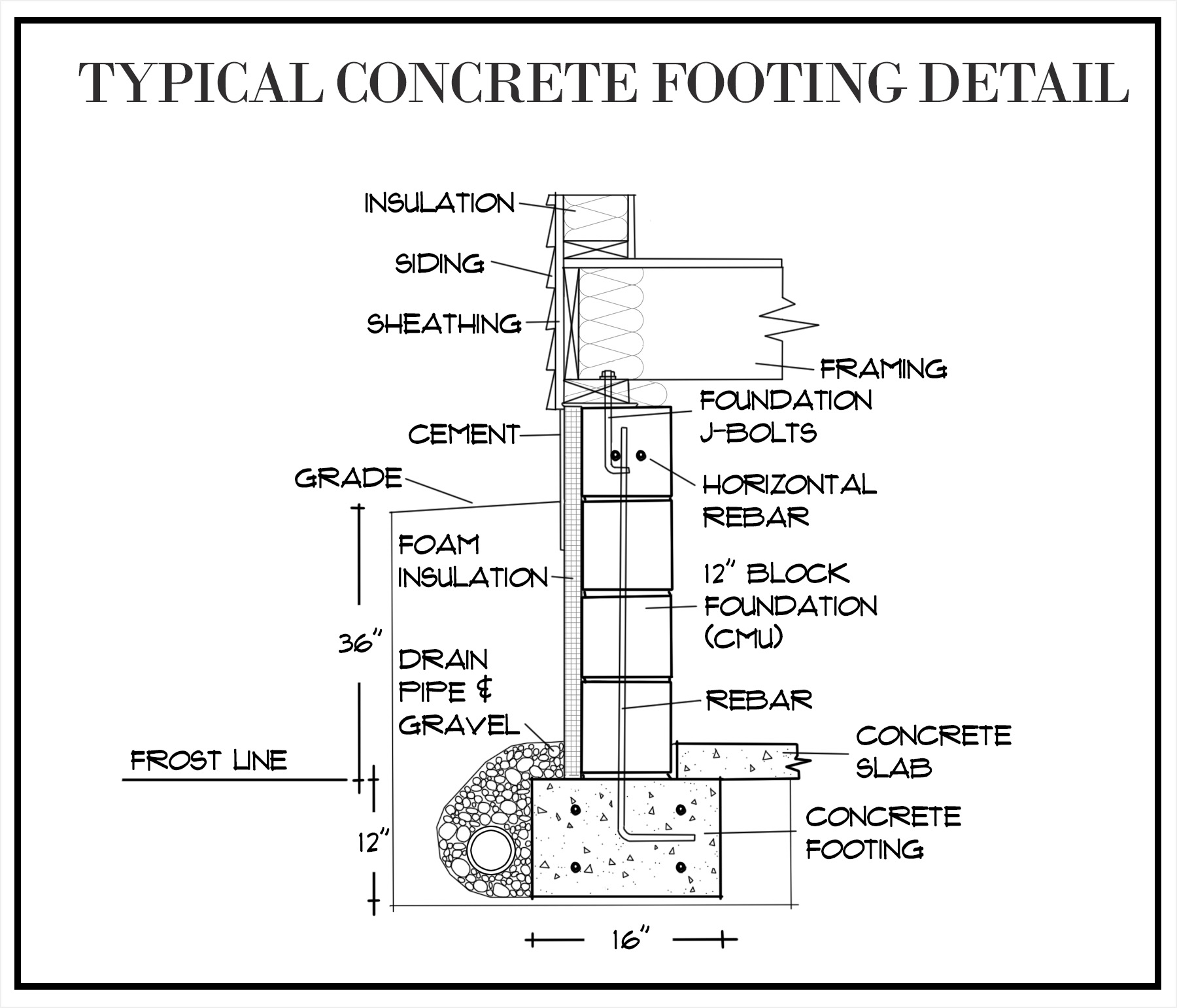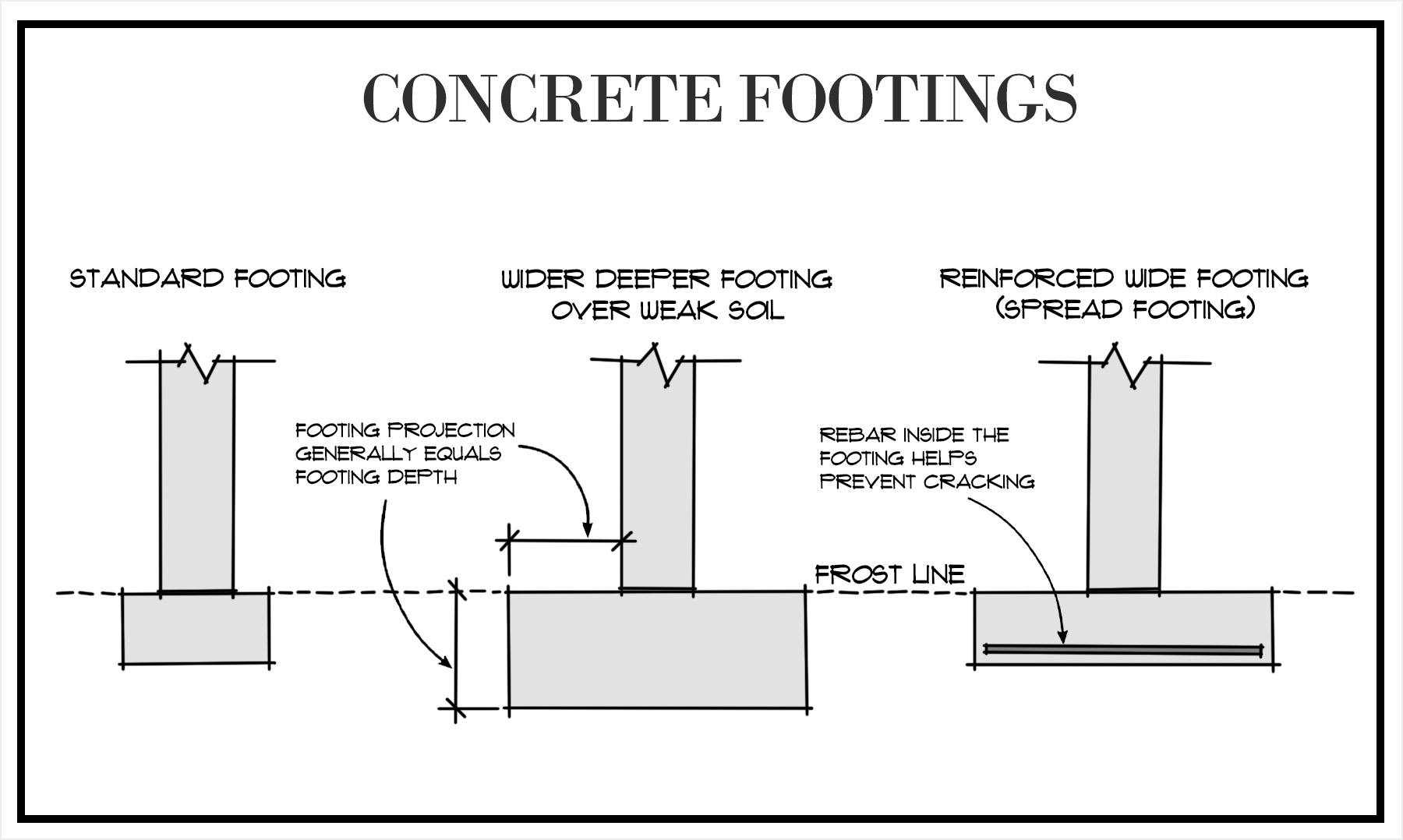
What Are Concrete Footings?
Concrete footings are a very important part of a foundation. Homes, buildings, bridges, decks, retaining walls, and structural slabs. They’re typically made of concrete that’s poured into an excavated trench or hole and have reinforced steel rebar inside. Rebar reinforces the footing from the inside and prevents cracking. The purpose of a footing is to support the weight placed on top of it. In some cases, that may be an entire home. Footings are the base that everything else is built on top of, so they need to be super strong and stable to prevent settling. This makes them especially important in areas with weak soil.
Footings are located under ground with a base below the frost line. They’re generally poured over compacted gravel which provides a level base and some drainage. This helps keep footings strong and stable.
All the weight of a building rests on top of the footing, so stability and strength are very important. If the footings fail, so can the building. Most cracked foundation walls and sagging homes we repair are caused by a cracked footing.
Concrete footings are typically poured into an excavated trench or hole which is often lined with forms. Concrete is wet when poured and will dry into any form it’s poured into. Forms are used to shape the footing until the concrete dries and hardens.
A footing’s strength is measured in p.s.i. (pounds per square inch), which is dictated by the mix ratio used to create it.
Proper construction and placement of footings is crucial to provide support for the foundation and structure above.

What Are Footings?
Footings are a very important part of a foundation because they bear the load of everything built on top of them. Ultimately everything you build is resting on the Earth and footings create the attachment point between the foundation and soil. Strong footings provide support and prevent settling. Laying out the footings is one of the first things we do when building a home. They have to be excavated and poured perfectly in order to support the structure for generations.
Under every home, building or other large structure is a foundation. And under almost all foundations are footings. They’re what the foundation is built on top of.
A home is only as strong as it’s foundation. And a foundation is only as strong as it’s footings. The leading cause of foundation damage I see are due to footing cracks. And the leading cause of footing cracks is settling. Mostly due to poor drainage.
There’s no one size fits all footing design. Each footing is designed specifically to support the load built on top of it and for the soil it’s poured into. In good soil, pouring footings is much easier because the soil helps support and stabilize the footing. However, that same footing may not do so well in weak bearing conditions. It’s not uncommon to see settling and cracks when soil bearing capacity is low.
It’s very important to pour string footings but even more so when soil conditions are bad. You won’t get much help from the soil around and beneath the footing so they need to do more of the work.
The Role Of Footings
Buildings are supported from the ground up. The building is supported by it’s foundation which is supported by it’s footings which are supported by the Earth. One break in that chain can lead to structural failure. A well built foundation is a very important part of constructing a home if you want it to last.
Concrete footings are used for a lot more than just building homes and buildings:
- Decks
- Fences & Mail Boxes
- Bridges
- Damns
- Retaining Walls
Footings must have enough thickness, width, strength, and reinforcement to support whatever load it’s carrying.
Concrete has very high compressive strength, which means it can carry a lot of weight without cracking. But it has very low tensile strength, which means it cracks easily if not properly supported. To solve this, reinforcement is added inside the footing which increases its tensile strength.
Builders place horizontal and vertical steel rebar inside the forms before the concrete is poured. The rebar is tied together to create a skeletal cage structure. By doing this, they combine the compressive strength of concrete with the tensile strength of rebar. This makes the footing less likely to fail under pressure.
A small amount of even settling isn’t that bad and usually won’t damage a house. But uneven settling can destroy a foundation. Footings and foundations can break, floors can sink and walls can crack. This can be prevented by properly designing your footings and using reinforcement.
Footings And Soil
It’s important to understand the bearing strength of the soil when designing a footing. The footings bear the load of whatever is built on top of it, but the soil bears the load of the footing. Ultimately, everything you build rests on the Earth. Footings provide the connection point between the Earth and building. This is why understanding you soil conditions are so important.
Working with very strong soils gives a builder a little margin for error. The ground helps support and stabilize the footings. But in weak soils a footing should be laid out and poured as close to perfect as possible.
Footings help spread the weight of a building so that the ground can bear the building’s weight. It’s important to compact the soil directly under the footing because it bears the most weight. Failing to compact your footing soil can lead to settling of up to 1/2″ in the first 6 inches of soil. That’s enough to cause cracks.
If you dig too deep and need to replace soil, it has a greater tendency to settle. I recommend always pouring footings on virgin soil because it’s tightly compacted. Instead of back-filling and compacting. Consider adding some compacted gravel.
We usually pour a layer of gravel below out concrete footings. This provides some drainage and helps create a strong flat base for the concrete.

Footing Size And Dimensions
The ideal footing size, dimensions and layout should be determined by an engineer or architect. They’ll design the footing size and depth as well as reinforcements and concrete requirements by calculating loads, soil conditions and other factors. It’s best to let Pros do the design work.
Soil’s bearing capacity can be measured by doing a boring test. Deep test bores are taken at various points which tell engineers what’s under the ground. Soil may appear strong at the surface but be very week 10-20 feet deep. Here in New jersey we occasionally have deep peat moss deposits which is considered weak soil. In these cases pilings can be driven into the ground to further support the footings.
Some footings can be shallow while others are deep. It all depends on the load requirements and soil conditions. If you’re building a house on weak soil, a wider footing, called a spread footing, can be used to spread the load onto a wide area. However if the soil is very strong, a much slimmer footing can be used. The most common footing size we pour is 12″ to 16″ wide which supports an 8″ to 12″ wall.
Most homes we build have footings at least 12″ below the frost line and are at least 12″ deep x 12″ to 16″ wide. Generally the footing should extend wider than the wall it’s supporting by a few inches on both sides.
Concrete Footings Should Be Level
The top and bottom of concrete footings should be level. This is a bit easier for the top because concrete is poured wet and generally self levels. But leveling the footing’s base is up to you.
When you dig a trench or hole for a concrete footing, try to make it as flat and level as possible. There are some rare exceptions to this which will be detailed on your plan, but generally speaking always keep footings level.
What you want to create is a level base so the footing can distribute it’s weight evenly. If the base isn’t level, weight can be distributed unevenly which may cause settling problems.
Concrete takes the shape of whatever it’s poured into. When pouring concrete piers this can create a problem if the base isn’t flat. For example, if you dig a deck footing and the bottom is cone shaped from the shovel, the concrete will dry with a point. Over time, the wight of the deck can drive that point deeper into the ground. This causes the deck to settle. You can prevent this by flattening the bottom of the hole which creates a flat footing.
If your footing trench or hole isn’t completely level I recommend spreading gravel. It’s easier to level out than dirt and compacts really well. It also provides drainage which helps prevent settling.
What’s The Difference Between A Foundation And Footing?
Footings and foundations typically go together, which is why many people consider them to be the same thing. While they are very similar and both support the weight of a structure, they’re different things.
A foundation bears the load of a structures and transfers it’s weight to the ground through the footing. Foundations sit directly on a footing and under the structure. They’re the middle man that transfers weight from the structure to the footing and then to the Earth. A footing comes in direct contact with the Earth. It’s the first load baring part of a strong foundation.
A footing and foundation serve slightly different purposes.
- Footings are designed to come in direct contact with the Earth. They carry the weight of the foundation wall and structure. For this reason they’re typically wider than foundation walls.
- Foundations sit on top of the footing. They transfer the weight of the structure onto the footing and then the Earth.
Both footings and foundations are an important part of building a strong and stable structure.
Buildings are built from the ground up, not the top down. So footings come first. Once the concrete footing is poured and hardened, a foundation is built on top of it. When the foundation is done a structure is built on top of that. All the weight of what’s built ultimately rests on the footing and Earth.
Does A Concrete Slab Need Footings?
Whether or not a concrete slab needs footings depends on what type of slab you’re pouring.
A concrete slab foundation needs footings to provide support for the foundation walls built on top. The slab portion of a slab foundation is what you walk on, it’s not what you build a foundation on top of. Slab foundations typically have footings around the edges and under any load bearing interior walls.
Simpler slabs like patios,driveways and sidewalks usually don’t have footings if they’re only used to walk or drive on. The thickness of the slab should be enough to support the loads placed on top. However, if a structure is built on top of the slab it needs a footing underneath to support the load. This turns a simple slab into a slab foundation.
What is The Meaning Of Footing In Construction?
The word footing describes the part of a structure’s foundation that touches the ground. They’re generally poured under ground and below the frost line. Footings create a strong and stable base that supports foundations and columns which support buildings and homes.
The main function of a footing is to transfer the vertical load of a structure directly to the soil.
Here are a few examples of footings:
- A home’s basement walls are generally sitting atop a concrete footing. The footing sits on the Earth. The foundation wall is built on top of the footing. Then the building is built on top of the foundation walls. All the weight of the entire structure transfers down onto the footing and to the Earth.
- A deck is typically built on top of round or square concrete piers. These are examples of footings. They generally sit below the frost line to prevent up-heaving.
- Fence posts and mail boxes are typically set in a cylinder of concrete. This is also considered a type of footing.
How Deep Do House Footings Need To Be?
In general, house footings should be at least 12 inches deep below virgin soil. They should also sit about 12 inches below the frost line to prevent up-heaving. The frost line is the depth to which the ground freezes in Winter.
Footings should be designed by an Architect or Engineer because many factors go into footing design.
Can You Pour A Concrete Slab And Footing Together?
A concrete slab and footing can be poured at the same time. This is called a Monolithic Slab.
Most footings and slabs are poured separately. The footing is poured first, then the foundation is built, and finally the lab is poured. This is the order in which most home’s are built. However, to save time and money, a slab and footing can be poured at the same time.
To pour a Monolithic slab, the footing and slab needs to be properly prepped for concrete. Forms have to be built to not only contain and shape the footings but also the slab sitting on top. Rebar, wire mesh, drainage and vapor barriers need to be in place prior to pouring. Since the slab and footings are poured all at once, they’re permanently connected.
There won’t be any way to do under slab work after the pour so it all needs to be done prior to pouring any concrete.
Summary: What Are Concrete Footings?
Concrete footings are a very important part of a foundation. Homes, buildings, bridges, decks, retaining walls and even small things like fences all use footings. They’re typically made of concrete that’s poured into an excavated trench or hole and have reinforced steel rebar inside. Rebar reinforces the footing from the inside and prevents cracking. The purpose of a footing is to support the weight placed on top of it. In some cases, that may be an entire home, in others a simple fence post. Footings are the base that everything else is built on top of. So they need to be super strong and stable to prevent settling. This makes them especially important in areas with weak soil.
Most footings are located many feet under ground with a base below the frost line. They’re generally poured over compacted gravel which provides a level base and some drainage. This helps keep footings strong and stable. All the weight of a building rests on top of the footing, so stability and strength are very important. If the footings fail so can the building. Most cracked foundation walls and sagging homes we repair are caused by a cracked footing.
Concrete footings are typically poured into an excavated trench or hole which is often lined with forms. Concrete is wet when poured and will dry into any form it’s poured into. Forms are used to shape the footing until the concrete dries and hardens.
A footing’s size, type and dimensions depend on the size and type of structure that will be built on top. This is why footings are designs by architects or engineers. Proper construction and placement of footings is crucial to provide support for the foundation and structure above.
If you have any questions or comments about concrete footings, email any time.

John Mazzuca | About | More Posts |
Custom Home Builder
John Mazzuca is a custom home designer and builder at Gambrick with over 25 years experience in the construction industry. John has designed, built and/or remodeled hundreds of homes, small buildings, and commercial projects. He writes about business, real estate, home building, and household electronics. His work has been featured in Fox Business, Better Homes & Garden, House Beautiful, and more.




















